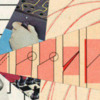How is it that a delightful child can turn overnight into a sullen, explosive, risk-taking adolescent? Jensen, a neurologist and mother of two sons, and Nutt, a Washington Post science writer, explore the biology of the teenage brain, in an effort to demystify teenage behavior for overwhelmed parents.
The good news is that adolescents are primed to learn. They tend to form memories more readily than adults do, and those memories seem to persist longer. The bad news is that because teenagers are so well equipped to learn, “they are also exceedingly vulnerable to learning the wrong things,” Jensen and Nutt write. The reward centers of their brains respond in heightened fashion to the neurotransmitter dopamine, which may explain why they are particularly vulnerable to addiction. Their brain wiring is also not yet fully insulated, or myelinated, which means that some of its signaling remains inefficient. Their frontal lobes, which are responsible for judgment and decision making, are among the last areas to complete myelination, meaning that they may still have “trouble linking up” with other parts of the brain. This could be why teenagers “sometimes find themselves in dangerous situations, not knowing what they should do next.”
[For more of this story, written by Amanda Schaffer, go to http://www.nytimes.com/2015/04...d&pgtype=article]




Comments (0)